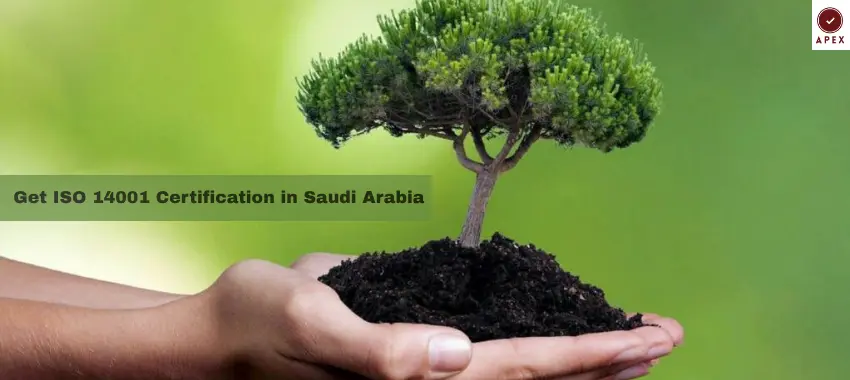
Companies in Saudi Arabia are increasingly aware of their effects on the environment. As the Kingdom Vision 2030 is all about sustainability, multiple organizations in Riyadh, Jeddah, Dammam, Jubail, and Al Khobar are currently seeking to achieve ISO 14001 Certification, the international standard of Environmental Management System (EMS). Some of these companies, such as Saudi Aramco, SABIC, NEOM, and Saudi Electricity Company, have already been leading the pack in implementing the ISO 14001. Regardless of the size of your business, you can accomplish the same thing by doing the right things.
Step 1: Learn What ISO 14001 Means
ISO 14001 is a global standard that assists companies in effectively managing their environmental issue. It offers companies the opportunity to minimize waste, conserve energy, and adhere to environmental regulations. Certainly, becoming an ISO 14001 certified company in Saudi Arabia assists in complying with the regulations of the National Center of Environmental Compliance (NCEC) and the Ministry of Environment, Water, and Agriculture. This is the initial step in understanding their requirements before proceeding to implement the same.
Step 2: Get Leadership Commitment
Top management contributes to the success of ISO 14001. To create a robust environmental culture, leaders should identify specific environmental objectives, delegate, and allocate resources. Leadership involvement can make a big difference, as experienced in the case of companies like SABIC and STC in large Saudi cities like Riyadh and Jeddah. Employees tend to support environmental efforts when their management is involved.
Step 3: Review Your Current Environmental Practices
Perform an analysis of your current environmental performance before developing a new system. This involves examining the way your business is run:
- Disposal and recycling of waste materials
- Energy and water use, Emissions, and pollution control
- Saudi environmental legislation
It is sometimes referred to as a gap analysis and is used to determine areas of improvement.
Step 4: Build Your Environmental Management System (EMS)
Once you understand your current performance, start building your Environmental Management System (EMS) according to ISO 14001 requirements. Your EMS should include:
- An environmental policy
- Objectives and targets for improvement
- Training programs for employees
- Clear documentation and procedures
In cities like Al Khobar and Dammam, where heavy industries are active, an EMS helps control waste, reduce emissions, and promote sustainability.
Step 5: Put the EMS into Action
Once you have created your EMS, you need to implement it within your organization. Make all employees aware of your environmental goals and how everyone can contribute.
Companies such as NEOM have demonstrated that effective communication and employee engagement translate into actual improvements in the environment. Unusual meetings and workshops contribute to creating awareness and ensuring that the system becomes a daily routine.
Step 6: Audit and Review Your System
Before certification, internal audits are necessary. They assist in detecting problems, maintain compliance, and train you to face the outside audit. Management should examine the outcome of internal audits to confirm that the system is functioning efficiently and to make necessary improvements. The constant audit keeps your system in line with the evolving environmental laws of Saudi Arabia.
Step 7: Get Certified by an Approved Body
When your company is prepared, the final audit should be carried out by an accredited ISO certification body (which SASO or IAS recognizes). The certification process consists of:
- Review of document - reviewing your EMS documentation
- On-site audit - verification that the system has been implemented correctly
A properly established EMS is the pillar towards attaining and sustaining ISO 14001 Certification in Saudi Arabia. It is at this point that most organizations engage the services of a seasoned ISO 14001 service provider like Apex SC, who offer advice, templates, and optimal practices based on the local needs.
Step 8: Keep Improving
Certification is not the end; it's the beginning of continuous improvement. Keep monitoring performance, updating procedures, and training staff regularly.
In cities like Dammam, Riyadh, Jeddah, and Jubail, companies that consistently improve their environmental systems gain better public trust, lower costs, and stronger partnerships.
The Importance of ISO 14001 to Saudi Businesses
The ISO 14001 certification assists organizations in:
- Adhere to Saudi environmental regulations
- Minimize energy and waste expenditures
- Bid on government and company contracts
- Be part of the Saudi Vision 2030 sustainability objectives
For industries such as construction, oil & gas, logistics, and manufacturing, ISO 14001 has become a symbol of responsibility and modern business excellence.
Expert Guidance Makes a Difference
Professional assistance is a lot easier to get certified in. The ISO 14001 Certification body in Saudi Arabia, such as Apex SC, is assisting businesses in Riyadh, Dammam, Jeddah, Al Khobar, and Jubail to successfully implement ISO 14001 – helping them through documentation, audits, and continuous improvement.
Click here: ISO Certification Requirements in Saudi Arabia
Conclusion
Becoming ISO 14001 certified is a practical way for Saudi organizations to build a greener and more sustainable future. By following this step-by-step process, your business can not only meet international standards but also support Saudi Arabia’s Vision 2030 and gain long-term credibility in the market.
FAQs
How to get ISO 14001 Certification in Saudi Arabia?
Develop an EMS, perform internal audits, and pass an external audit by an accredited certification body.
How long does ISO 14001 Certification take?
Usually between 3 and 6 months, depending on company size and readiness.
What are the benefits of ISO 14001 Certification?
Improved compliance, reduced waste, better efficiency, and stronger reputation.
What documents are needed for ISO 14001?
Environmental policy, objectives, legal register, audit records, and operational control procedures.
How much does ISO 14001 Certification cost?
Between SAR 10,000–40,000, depending on company size and scope.
